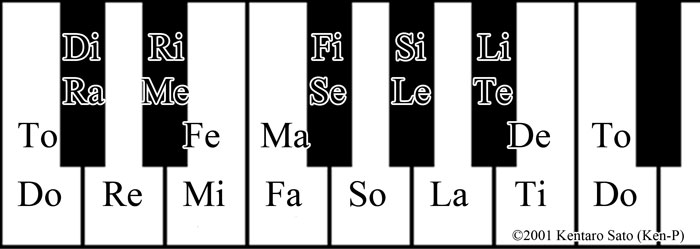Sato Method of Solfege Syllables
by Kentaro Sato (Ken-P)
![]()
This Method is an expansion and modification of the traditional method of solfege syllables which is widely used in the English speaking counties around the world.
Traditionally, there is no syllable assigned for the raised Mi and Ti (E# and B# in the key of C major), and the lowered Do and Fa (Cb and Fb in the key of C major). Ma was added to represent the raised Mi (E#), and To was added to represent the raised Ti (B#). Each vowel is selected after the enharmonic note’s vowel: Fa and Do. De was added to represent the lowered Do (Cb), and the Fe was added to represent the lowered Fa (Fb). Each vowel is selected because the all flatted syllables except Ra have “e” vowel.
All syllables are pronounced with a single consonant followed by a single vowel. This is a very practical modification for singers. No diphthong. No ending consonant.
For example, use open Oh vowel for Do, instead of a dipthong as it appears in a word "doe." Use open Eh vowel for Re, instead of a dipthing as in a word "ray."
![]()


![]()
Q. Should I use "movable do" or "fixed do" system?
A. Fixed do with chromatic syllable (or movable do treating every music as if in key of C) should be easier introduction of solfege syllable for students, because students don't have to learn the theory of different keys and tonal relationship.
When the students start to learn theory and other music skills, using movable do is the best way to acquire practical application of theory, tonal sensation and relationship, and transposition.
If a student get to the point to learn sight-singing of atonal music, just suggest to use fixed do with chromatic syllable (or movable do treating every music as if in key of C).
In this way, students acquire every possible benefit that solfege syllable can offer. Of course, this is applicable for people who have perfect pitch and people who are not.
![]()
Q. Should I use "La"-based solfege or "Do"-based solfege for various minor scales?
A. La-based minor scale solfege is easier to teach because students don't have to learn the theoretical difference between major and minor scales. However, I have found that using "Do"-based minor scale solfege is much more beneficial in a long run, because students seems to acquire and feel the core of the "tonality" better. The core of the "tonality" is: Tonic-Dominant (or Do-So) relationship, and resolution of leading-tone (Ti resolving to Do).
![]()
Major Sclae
Do-Re-Mi-Fa-So-La-Ti-Do

Natural Minor Sclae
Do-Re-Me-Fa-So-Le-Te-Do

Harmonic Minor Sclae
Do-Re-Me-Fa-So-Le-Ti-Do

Melodic Minor Scale
Do-Re-Me-Fa-So-La-Ti-Do, Do-Te-Le-So-Fa-Me-Re-Do

Ascending chromatic scale
Do-Di-Re-Ri-Mi-Fa-Fi-So-Si-La-Li-Ti-Do

Descending Chromatic Scale
Do-Ti-Te-La-Le-So-Se-Fa-Mi-Me-Re-Ra-Do

![]()
![]()